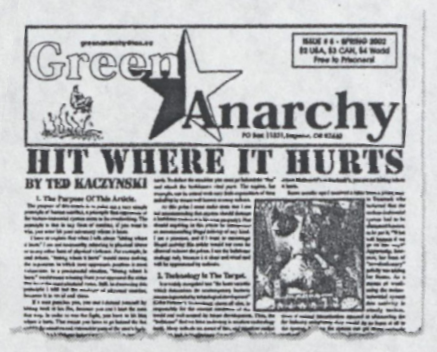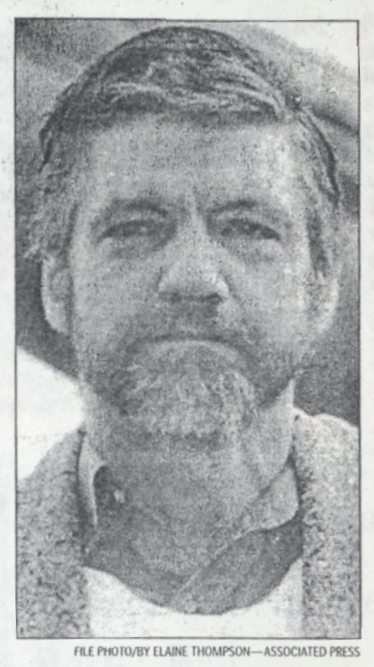Dan Eggen and Dominic Gates
From Jail Cell, Unabomber Finds a Forum
Essay in Newsletter Pits Prison Rules vs. First Amendment Claims

The last time Theodore Kaczynski had a lengthy article published, his 35,000-word manifesto led his brother to identify him as the Unabomber, the man who had killed three people and injured 23 more during a 17-year mail-bomb spree that authorities could not solve.
Seven years later, locked behind the walls of a federal maximum security prison in Colorado, Kaczynski has apparently managed to get his controversial views in print again.
In an article published this spring by Green Anarchy, a radical environmental newsletter, Kaczynski calls on revolutionaries to “eliminate the entire techno-industrial system” by “hitting where it hurts” and disparages the activities of most radicals as “pointless.”
The essay, which repeats Kaczynski’s contention that modern society must be destroyed, has disturbed Unabomber survivors as well as prison officials, who are investigating whether the article violated rules that prohibit prisoners from publishing under their own names. Even the newsletter’s editors objected to some of Kaczynski’s views.
“I’m surprised that he’s able to write these things,” said Charles Epstein, a California physician and researcher who lost fingers from one hand when he opened a mail bomb sent by Kaczynski in 1993. “To the extent that his message potentially influences malleable people, it’s a concern.”
Authorities are still reviewing the case, but they said they believe the essay is authentic. U.S. Bureau of Prisons officials declined to say whether they have asked Kaczynski about the article or whether they may have come across it as they monitored his outgoing mail.
However, they noted that the article expresses views similar to Kaczynski’s opinions in the 1995 manifesto — which was jointly published by The Washington Post and the New York Times after the then-unidentified bomber threatened more attacks if it was not printed.
One of the newsletter’s editors, John Zerzan of Eugene, Ore., said he corresponds regularly with Kaczynski and received the essay from him, written in longhand.
“It’s right in keeping with his general take on things,” said Zerzan, 58, a longtime radical author who previously attracted notoriety by visiting Kaczynski in prison and defending some of his actions. “There’s not a total agreement with his point of view among the editors. But very often his views are worth publishing.... We definitely concur with his views on the dangers of technology.”
The Green Anarchy article is not Kaczynski’s first published piece from prison, but it is the longest and the one most similar to his 1995 manifesto. In 1999, OFF! Magazine, produced by students at the State University of New York at Binghamton, published a “parable” by Kaczynski entitled “Ship of Fools,” in which Kaczynski ridiculed the advocates of animal rights, gay rights and other leftist causes.

The fall 2001 issue of Green Anarchy — whose slogan is “For the Destruction of Civilization ... For Reconnection to Life!” — published a letter from Kaczynski complaining that Subcomandante Marcos, leader of the Zapatista rebels in Chiapas, Mexico, was insufficiently pure as a revolutionary because he advocates bringing water and electricity to peasants. Letters to the editor do not violate prison regulations.
Kaczynski, now 60, is serving four consecutive life terms in the federal prison near Florence, Colo., where he is confined to his cell 23 hours a day but is allowed mail privileges.
The Bureau of Prisons is generally free to monitor all the incoming and outgoing mail of the inmates, except for their correspondence with legal counsel, the news media and other specially designated people, said spokesman Daniel R. Dunne. The Green Anarchy essay would not have been allowed to leave the prison if it had been recognized as an article for publication, Dunne said.
“We don’t know if it was sent out legitimately or not,” Dunne said. “This is a matter we are reviewing.”
In a rambling style, Kaczynski’s “Green Anarchy” piece dismisses the tactics of anti-globalization and pro-environment militants who focus on “smashing up McDonald’s or Starbucks” instead of working to “destroy ... modern technology itself.”
He says the “most promising target for political attack is the biotechnology industry,” whose leaders should be encouraged to “get out of biotech.”
Kaczynski repeatedly stresses in the treatise that he is not advocating violence or “illegal activity of any kind,” but he also uses a number of violent analogies, including fistfights and vandalism against bulldozers.
“Just as in a fist-fight, you can’t win by hitting at the fist,” Kaczynski writes. “You have to go behind the fist and strike at the most sensitive and vital organs of the system. By legal means, of course, such as peaceful protests.”
Kaczynski’s article was accompanied by a note from the “Green Anarchy editorial collective” explaining that, while the group supports Kaczynski as “an anarchist political prisoner,” it disagrees with his views on feminism and other “liberation struggles.”
Elsewhere in the same issue, the newsletter lists Kaczynski as a “prisoner of war” along with others convicted of crimes that include murder and arson. The periodical describes the Unabomber’s victims as “industrialist scum.”
In response to a reporter’s e-mail query, an anonymous spokesman for Green Anarchy said that the editors were confident of the article’s authenticity because prisoners are not allowed to send mail under pseudonyms and because Zerzan is familiar with Kaczynski and his writings. “We know that it was Ted K. that submitted the article to us,” the spokesman wrote.
Zerzan said he did not keep Kaczynski’s original submission.
Kaczynski’s brother, David, said he had not seen the Green Anarchy piece and has not communicated with his brother in years. “The situation hasn’t really changed,” he said. “We’ve had no contact with Ted at all.”
David Kaczynski’s reading of the Unabomber manifesto prompted him to alert federal authorities about his brother, who was arrested in April 1996 at his 10-by-12-foot cabin near Lincoln, Mont.
The issues in the Green Anarchy case also illustrate the ongoing struggle between prison officials and inmates over the bounds of First Amendment rights. Dunne said the prisons bureau believes it has the right to prohibit “bylined” stories by inmates. The government cites a ruling by a U.S. district court judge in the late 1980s, which agreed with the previous Bush administration that such writing could be regulated because newspapers and magazines are incoming mail.
Under federal prison rules, “an inmate currently confined in an institution may not be employed or act as a reporter or publish under a byline.”
But civil liberties and First Amendment experts say the government is on shaky ground. For example, they said, the case cited by prisons officials was thrown out by an appellate court after the prisoner involved, San Francisco Chronicle contributor Danny Martin, was released on parole.
“Publishing materials is at the heart of the First Amendment,” said David Hudson, an attorney in the First Amendment Center at Vanderbilt University in Nashville. “They might have a hard time showing a security interest in prohibiting an inmate from just publishing an article.”
